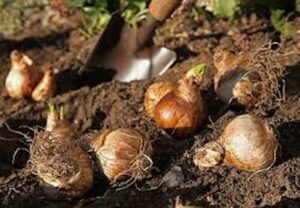A bulb plant can be grown indoors or outdoors. Bulbs, swollen underground stems with scaley leaves, store food and provide energy for the plants we see above ground. They are also used for propagation. Bulbs should be planted deep enough in the soil so that they are totally covered. The depth a bulb is planted, depends upon the plant variety. There are true bulbs and there are rhizomes, corms, and tubers that are sometimes included as types of bulbs. Bulb plants that keep their leaves all year are used as houseplants. Bulb plants that lose their leaves after they flower and become dormant are usually used as outdoor plants.
Certain environmental conditions, such as the change in temperature from winter to spring, encourage bulb plants to produce flowers. Once the plant has finished flowering and is only a green leafy plant, the plant rests for a few months. During this time, the bulb absorbs and stores nutrients from the soil to help the plant flower again the following year.

Some indoor plants that grow from bulbs are: amaryllis, calla lily, caladium tubers, False Shamrock plant (Oxalis triangularis), daffodils, begonia tubers, and cyclamen corms
